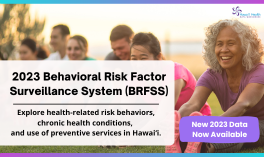The Behavioral Risk Factor Surveillance System (BRFSS) data for 2019 are now available in Hawaii-IBIS. The BRFSS collects uniform, state-specific data on preventive health practices and risk behaviors that are linked to chronic diseases, injuries, and preventable infectious diseases in the adult population. It is an annual landline and cell phone telephone survey of Hawai‘i adults that is conducted throughout the year. We’ve added many new indicators, changed the default report, and added new health behavior and conditions dimensions for analysis. See the Data Release Notes for a complete list.
Here are some highlights from 2019. Use the hyperlinks to create your own queries for each indicator!
- Adults who were unable to work were almost twice as likely (32.3%) to report poor mental health for at least 14 days in the past month than adults who were unemployed (17.3%), and three times more likely than adults who were employed for wages (9.9%).
- The primary care service areas (PCSA) with the highest prevalence of heavy or binge drinking were Molokaʻi (34.9%), Lānaʻi (32.8%), Lāhainā (32.3%), Hanalei (30.7%) and Makawao (27.9%).
- Adults with lower education attainment were more likely to skip going to the doctor when they needed to due to the cost. (27.6% for adults who never attended school/up to middle school compared to 5.4% of for college graduates).
- While 9.1% of adults reported have been diagnosed with diabetes (age-adjusted prevalence), adults who had obesity were three times more likely to have diabetes than those who did not have obesity (18.6% compared to 6.0%).
- Adults who have an independent living disability (difficulty running errands alone due to physical, mental or emotional condition) were more than three times as likely to be in the lowest poverty level (9.8% at 0-130%) than the highest poverty level (3.0% at 186%+).




